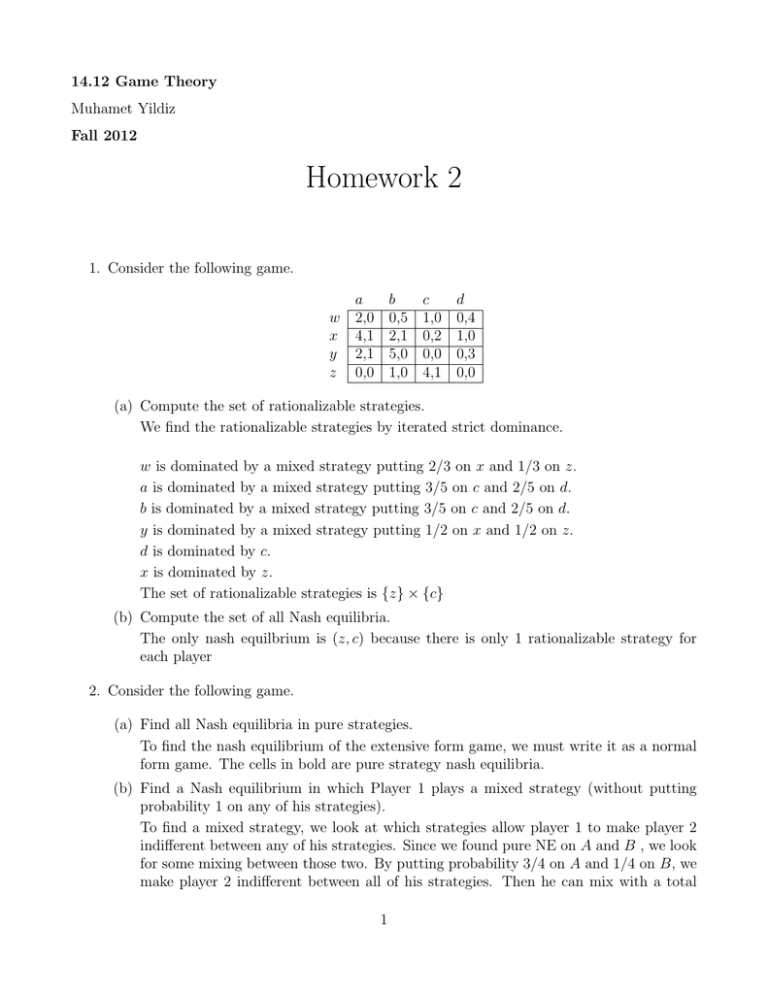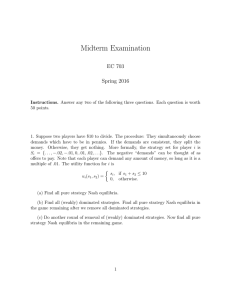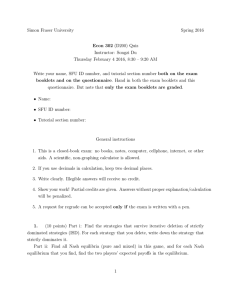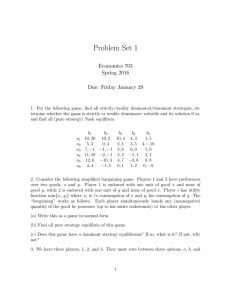Homework 2
advertisement

14.12 Game Theory
Muhamet Yildiz
Fall 2012
Homework 2
1. Consider the following game.
w
x
y
z
a
b
c
2,0 0,5 1,0
4,1 2,1 0,2
2,1 5,0 0,0
0,0 1,0 4,1
d
0,4
1,0
0,3
0,0
(a) Compute the set of rationalizable strategies.
We find the rationalizable strategies by iterated strict dominance.
w is dominated by a mixed strategy putting 2/3 on x and 1/3 on z.
a is dominated by a mixed strategy putting 3/5 on c and 2/5 on d.
b is dominated by a mixed strategy putting 3/5 on c and 2/5 on d.
y is dominated by a mixed strategy putting 1/2 on x and 1/2 on z.
d is dominated by c.
x is dominated by z.
The set of rationalizable strategies is {z} × {c}
(b) Compute the set of all Nash equilibria.
The only nash equilbrium is (z, c) because there is only 1 rationalizable strategy for
each player
2. Consider the following game.
(a) Find all Nash equilibria in pure strategies.
To find the nash equilibrium of the extensive form game, we must write it as a normal
form game. The cells in bold are pure strategy nash equilibria.
(b) Find a Nash equilibrium in which Player 1 plays a mixed strategy (without putting
probability 1 on any of his strategies).
To find a mixed strategy, we look at which strategies allow player 1 to make player 2
indifferent between any of his strategies. Since we found pure NE on A and B , we look
for some mixing between those two. By putting probability 3/4 on A and 1/4 on B, we
make player 2 indifferent between all of his strategies. Then he can mix with a total
1
Table 1: Table
Ll Lr Rl Rr
A 3,1 3,1 0,0 0,0
B 0,0 0,0 1,3 1,3
C 1.5 0.5
1
0
probability of 1/4 on Ll and Lr and 3/4 probability on some combination of Rl and
Rr. This makes player 1 indifferent. In addition, we must check that C is not the best
response to player 2’s strategy. To do that, we need 1.5σ(Ll) + 0.5σ(Lr) + σ(Rl) < 0.75.
For this to be true, player 2 must put positive probability on Rr.
There is another set of mixed equilibria: Player 2 plays Rl and Player 1 mixes, putting
probability p ∈ [1/3, 1] on B and 1 − p on C.
3. Use backwards induction to compute a Nash equilibrium of the following game.
After L, player 2 plays B and player 1 plays A. Player 1’s equilibrium utility from L is 3.
After Rr, player 1 plays y, so after R player 2 will choose to play l. Player 1’s equilibrium
utility from R is 2, so player 1 will play L. The nash equilibrium from backwards induction
is LAy, Bl.
4. (a) For p > q + c (1 − 2x) , all kids go to firm 2. Thus, the revenue for firm 1 and 2 are zero
and q , respectively. For p = q + c (1 − 2x), kids from x0 ≤ x are indifferent and kids
from x0 > x prefer firm 2. The revenue for firm 1 and 2 are 21 px and 21 px + q(1 − x),
respectively. Similarly, for q > p+c (1 − 2x), the revenue for firm 1 and 2 are p and zero.
For q = p + c (1 − 2x), the revenue for firm 1 and 2 are px + 12 p(1 − x) and 12 q(1 − x).
For |p − q| < c (1 − 2x), we have an interior solution: there is a “mid-point” x∗ such
that x < x∗ < 1 − x and kid at x∗ is indifferent. In other words,
c |x∗ − x| + p = c |x∗ − (1 − x)| + q
Solving, we get
x∗ =
1 q−p
+
2
2c
Note that |p − q| < c (1 − 2x) implies x < x∗ < 1 − x. For |p − q| < c (1 − 2x), the
revenue for firm 1 (located at x) is
1 q−p
∗
x p=
+
·p
2
2c
For firm 2 (located at 1 − x), the revenue is
1 p−q
∗
(1 − x ) q =
+
·q
2
2c
(b) Strategy of firm 1 is to choose p ∈ [0, ∞] and Strategy of firm 2 is to choose q ∈ [0, ∞].
Utility (payoff) of firm 1 is zero if p > q + c (1 − 2x), p if q > p + c (1 − 2x), 12 px if p =
2
q+c (1 − 2x) , px+ 21 p(1−x) if q = p+c (1 − 2x), and 21 + q−p
·p if |p − q | < c (1 − 2x).
2c
Utility of firm 2 is 0 if q > p + c(1 − 2x), q if p > q+ c(1 − 2x), 12 qx if q = p + c(1 − 2x),
qx + 12 q(1 − x) if q = p − c(1 − 2x), and 12 + p−q
· q if |p − q| < c (1 − 2x).
2c
(c) If q ≥ p + c(1 − 2x), firm 2 would deviate to q = p + c(1 − 2x) − , where > 0 and is
small, as
1
p − (p + c(1 − 2x) − )
1
+
{p + c(1 − 2x) − } − {p + c(1 − 2x)} x > 0
2
2c
2
similarly, if p ≥ q + c(1 − 2x), firm 1 would deviate to p = q + c(1 − 2x) − , where
> 0 and is small. Thus, to search Nash equilibrium, we only need to consider the
case |p − q| < c (1 − 2x). Best response functions are given by the first order conditions
(FOC): q BR (p) = p+c
, pBR (q) = q+c
. Solving, we get p = q = c. This is the unique
2
2
Nash equilibrium.
3
MIT OpenCourseWare
http://ocw.mit.edu
14.12 Economic Applications of Game Theory
Fall 2012
For information about citing these materials or our Terms of Use, visit: http://ocw.mit.edu/terms.









